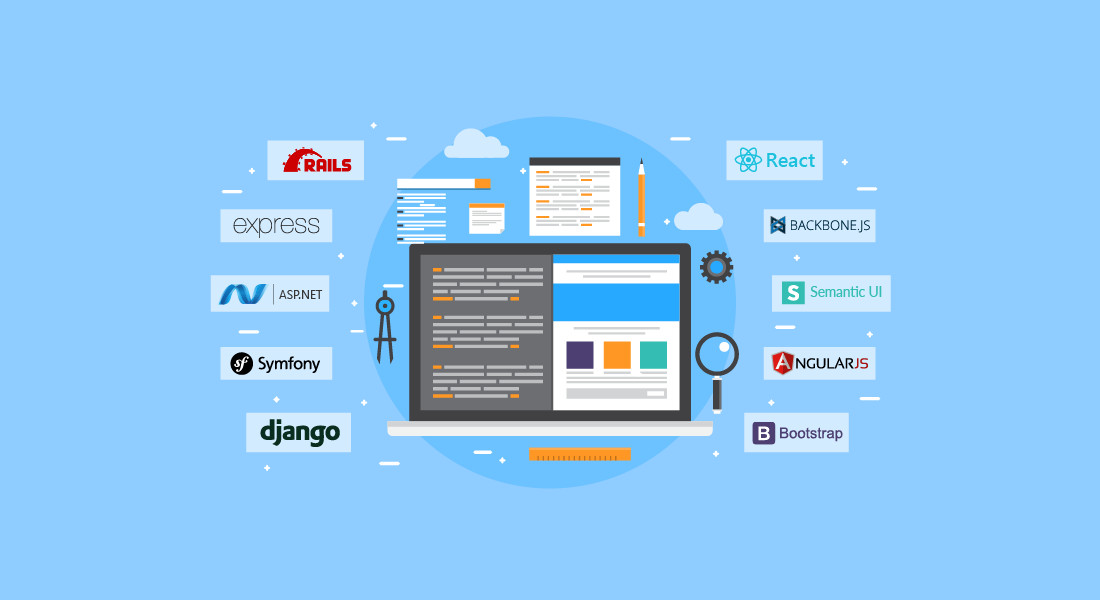Given the plethora of user-friendly frameworks for both backend and frontend, developers have not to reinvent the wheel when developing a web application. In this article, we will discuss web applications in detail.
What is a web application?
Web application is a program, one part of which loads into a browser and interacts with the user (the visual interface part). In contrast, the other part resides on a web server, executes requests from the former, and then returns a response. The part loaded into the browser and interacted with by the user is called the client part (frontend). The server part of the web application (backend) resides on the web server.
How are web applications different from websites?

Although both a website and a web application are used with a browser, they have significant differences.
A website is a collection of web pages, most often of an informational nature. It may contain content in the form of text, images, audio or video, and so on. Websites provide the user with ready-made HTML pages available for viewing. Interaction with them is limited. Most of the time, you can only use a search or subscribe to a newsletter. Authentication is not required. A company website is a typical example of a website. Also, such sites are often referred to as static sites.
A web application is interactive and allows people to enter data, process it dynamically, and get some results. In addition, web applications can be customized according to one's requirements. Various parts of a web application page are updated on the fly after user interaction, like a news feed in a social network.
People must be authorized to use the features of a web application. Otherwise, anyone can access their data and settings. Good examples of a web application are a social network or a CRM with Telegram integration, which combines messaging and data management.
Let's summarize the main differences between a web application and a website.
| Website | Web application |
|---|---|
| Allows you to view data | Allows you to manipulate data |
| Can be used without authentication | Authentication required |
| Outputs pre-prepared HTML pages, mostly with static files | HTML page fragments are generated and updated on the fly |
| Easier to develop | Requires development |
| Less customization for the visitor | Gives more customization for the user. This generates complexity, the downside of which is potential bugs |
Despite all the differences, in some cases, the boundaries between websites and web applications blur. Websites can include web applications or have some of their characteristics. For example, WordPress stores information in a MySQL relational database and provides many interactive features for administration.
If you're curious about how databases differ, check out our article on PostgreSQL vs MySQL vs MongoDB to make an informed choice for your web development needs.
How do web applications work?

Web applications consist of a server-side (back-end) and a client-side (front-end). Users interact with the client side through an interface displayed in a browser (Chrome, Firefox, Safari, Edge, etc.). The request is sent to the server over the internet at the user's command. On the server, it is processed by server-side code and returns a response to the client.
The response can contain both a ready-made HTML page and a page template or data, for example, in XML or JSON format. It depends on the page's selected type of rendering (forming). That is, the page can be sent without any changes (static page), or the backend changes it and then sends it to the browser (dynamic page). Rendering can be done entirely on the server, or in different ratios distributed between the server and the client, or performed only by the client.
The first web pages contained only text in HTML format. Over time, images and tables were added, but web pages remained static in the truest sense of the word. Over time, technology emerged to make them dynamic.
Examples of web applications
Examples of web applications are:
- Mailbox (Gmail)
- Text editors (Google Docs)
- Social networks (Facebook)
- E-commerce stores (Amazon)
- Cloud storage (Dropbox)
- Online note-taking (Evernote)
- Project management systems (Trello)
There are also many other applications that you undoubtedly use.
Benefits of web applications
A web application has many advantages, including those listed below:
- It does not require installation on your hard disk and, therefore, does not take up much space
- It does not require updates because it is updated centrally
- It can be used from any device that has a web browser
- It is platform and operating system (OS) independent: if the web application is compatible with the browser, it works
- The developer does not need to create client applications for different OSs because the browser is used
If your development team lacks MERN experts, MaybeWorks IT staff augmentation provider is ready to help you.
Utilization of web applications

Web applications can be developed and used for a variety of purposes. They allow people to exchange information and conduct transactions, sell and buy goods and services online, collaborate on projects, create text files, spreadsheets, and presentations, and share them with other users.
Web applications can be used to manage notes and task lists, manage files in the cloud, convert values from one unit of measurement to another, translate texts, create parsers, and so on. They are used in many different areas and even integrated into other tools — including messaging platforms, so leveraging business in Telegram through web apps is no longer surprising.
Web application architecture

Depending on the load distribution between the client and server side, we can distinguish several types of architecture, from predominantly server-based to predominantly client-based. Progressive web applications, which have some of the capabilities of desktop applications, stand out. Let's take a closer look at these architecture types.
Server-side web applications
The entire load is placed on the server side. The application accepts a request, determines which page should be rendered, and returns the corresponding HTML page. It can be either static or dynamic.
To generate the response, the backend can access the database for the necessary information to populate the page template.
Web applications using AJAX
When the first request is made to the page, the HTML code of the wireframe is passed to the page. JavaScript code asynchronously loads the rest of the page. It can send requests to the server on the fly and process its responses in XML (eXtended Markup Language) or JSON (JavaScript Object Notation) format. This technology is called Asynchronous JavaScript And XML (AJAX), demonstrating why JavaScript is used in web development for its capability to build interactive and responsive applications.
Client applications
The entire load is placed on the client side. The server only delivers HTML code with links to styles and JavaScript scripts, and these scripts provide the logic, display, and load the required content. This approach is similar to the way the Bun JavaScript runtime optimizes server responses, focusing on efficient handling of client-side tasks.
All interaction with the user takes place on a single page, so such applications are called single-page applications (SPA). The user performs some actions, sends a request, and receives a response without reloading the page. This approach is common in Ionic Node JS projects, where smooth and fast user experiences are essential.
To create single-page web applications, frameworks like Nest.js, Backbone.js, Angular, Vue.js, and React are often used, with TypeScript commonly integrated to enhance code reliability and maintainability. Many teams find that a JavaScript convert to TypeScript process significantly improves the scalability and robustness of their SPA projects.
MPA (multi page application)

MPA is a type of web application in which each page is re-loaded as you navigate between them. Each page can have its own HTML, CSS, and JavaScript, and it is completely reloaded each time it is requested. In MPA, each page is a separate view of the application.
This approach differs from SPA (Single-Page Application), in which the application loads a single page and then dynamically changes its content without reloading the page when the user interacts. When comparing SPA vs MPA, the entire application code in the first is typically loaded once at startup, and it manages transitions between different "pages" without actually loading new pages from the server. This method is becoming increasingly popular in the context of new trends in web development, as it enhances user experience and application performance.
MPA and SPA have their strengths and weaknesses and are used depending on the requirements of the project.
PWA (progressive web application)

Progressive web applications (PWAs) are web applications that are developed using certain specialized technologies and standard templates that allow them to take advantage of the benefits of desktop and web applications.
Progressive web applications can store data on the client side, so they can be used without an internet connection and work with data faster.
They have the following characteristics:
- Searchability. Content can be found through search engines.
- Installability. Applications can be accessed from the device's home screen or in the application launcher.
- Linking capability. You can pass a link to a progressive web application to another user.
- Network independence. Work without an internet connection or with a weak connection.
- Progressive enhancement. Available at a basic level in older browsers, with full functionality available in newer browsers.
- Re-engagement. When new content is available, the app can send notifications.
- Adaptive design. Available on any device with a screen and browser, including cell phones, tablets, laptops, TVs, fridges, etc.
- Security. The connection between the user, the app, and the server is secure, and third parties cannot access sensitive data.
At MaybeWorks, our developers have sufficient experience in developing PWA. If you need to augment your team with reak experts, feel free to contact us right now.
MaybeWorks - your reliable IT staff augmentation provider

MaybeWorks as an IT staff provider is highly versed in complex web application development. You can ask us to support your development team regarding any web app type or functionality.
The last case was PWA working as a video-sharing social network. This web app allows sharing 30-second videos with a 12-hour self-destruct timer, which can be elongated depending on the video's popularity.
We augmented the client`s development team with Full Stack Developers to:
- Create an application using a Serverless framework in pair with AWS Lambda
- Upgrade Node.js for optimal NodeJS app development
- Handle integration with AWS (Amazon S3, Amazon Glacier)
- Create the app as user-friendly as possible
- Develop database (MongoDB + mongoose.js)
- Create an admin panel using React + Redux
All in all, our Full Stack Developers joined the project from the beginning and created most features from scratch.
Feel free to contact us to discuss the assistance of your web development team.















